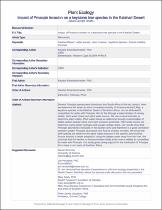JavaScript is disabled for your browser. Some features of this site may not work without it.
- ResearchSpace
- →
- Research Publications/Outputs
- →
- Journal Articles
- →
- View Item
| dc.contributor.author |
Schachtschneider, K

|
|
| dc.contributor.author |
February, EC

|
|
| dc.date.accessioned | 2013-06-12T12:44:15Z | |
| dc.date.available | 2013-06-12T12:44:15Z | |
| dc.date.issued | 2013-04 | |
| dc.identifier.citation | Schachtschneider, K and February, E.C. 2013. Impact of Prosopis invasion on a keystone tree species in the Kalahari Desert. Plant Ecology, vol. 214(4), pp 597-605 | en_US |
| dc.identifier.issn | 1385-0237 | |
| dc.identifier.uri | http://link.springer.com/article/10.1007%2Fs11258-013-0192-z | |
| dc.identifier.uri | http://hdl.handle.net/10204/6778 | |
| dc.description | Copyright: 2013 Springer Verlag. This is the Pre/post print version of the work. The definitive version is published in Plant Ecology, vol. 214(4), pp 597-605 | en_US |
| dc.description.abstract | Several Prosopis species have been introduced into South Africa in the last century many of which have become invasive. Here we determine the extent to which increased mortality of Acacia erioloba, a keystone species in the Kalahari, can be attributed to competition for water with Prosopis. We do this through a determination of canopy vitality, plant water stress and plant water source. We use a visual estimate to determine plant vitality. Plant water stress we determine through a combination of stable carbon isotope ratios and xylem pressure potentials and plant water source we determine using stable hydrogen and oxygen isotope ratios. Our results show that Prosopis abundance increases in the riparian zone and that there is a good correlation between increased Prosopis abundance and Acacia erioloba mortality. We show that both species are reliant on the same water resource in the riparian zone but that Acacia erioloba uses a deeper water source away from the river. We that the decline in Acacia erioloba vitality at the river is related to competition for water with Prosopis. We conclude that our study gives strong support for the eradication of Prosopis from rivers in arid parts of Southern Africa. | en_US |
| dc.language.iso | en | en_US |
| dc.publisher | Springer Verlag | en_US |
| dc.relation.ispartofseries | Workflow;8623 | |
| dc.subject | Stable isotopes | en_US |
| dc.subject | Resource competition | en_US |
| dc.subject | Alien invasive | en_US |
| dc.subject | Oxygen isotope ratio | en_US |
| dc.title | Impact of Prosopis invasion on a keystone tree species in the Kalahari Desert | en_US |
| dc.type | Article | en_US |
| dc.identifier.apacitation | Schachtschneider, K., & February, E. (2013). Impact of Prosopis invasion on a keystone tree species in the Kalahari Desert. http://hdl.handle.net/10204/6778 | en_ZA |
| dc.identifier.chicagocitation | Schachtschneider, K, and EC February "Impact of Prosopis invasion on a keystone tree species in the Kalahari Desert." (2013) http://hdl.handle.net/10204/6778 | en_ZA |
| dc.identifier.vancouvercitation | Schachtschneider K, February E. Impact of Prosopis invasion on a keystone tree species in the Kalahari Desert. 2013; http://hdl.handle.net/10204/6778. | en_ZA |
| dc.identifier.ris | TY - Article AU - Schachtschneider, K AU - February, EC AB - Several Prosopis species have been introduced into South Africa in the last century many of which have become invasive. Here we determine the extent to which increased mortality of Acacia erioloba, a keystone species in the Kalahari, can be attributed to competition for water with Prosopis. We do this through a determination of canopy vitality, plant water stress and plant water source. We use a visual estimate to determine plant vitality. Plant water stress we determine through a combination of stable carbon isotope ratios and xylem pressure potentials and plant water source we determine using stable hydrogen and oxygen isotope ratios. Our results show that Prosopis abundance increases in the riparian zone and that there is a good correlation between increased Prosopis abundance and Acacia erioloba mortality. We show that both species are reliant on the same water resource in the riparian zone but that Acacia erioloba uses a deeper water source away from the river. We that the decline in Acacia erioloba vitality at the river is related to competition for water with Prosopis. We conclude that our study gives strong support for the eradication of Prosopis from rivers in arid parts of Southern Africa. DA - 2013-04 DB - ResearchSpace DP - CSIR KW - Stable isotopes KW - Resource competition KW - Alien invasive KW - Oxygen isotope ratio LK - https://researchspace.csir.co.za PY - 2013 SM - 1385-0237 T1 - Impact of Prosopis invasion on a keystone tree species in the Kalahari Desert TI - Impact of Prosopis invasion on a keystone tree species in the Kalahari Desert UR - http://hdl.handle.net/10204/6778 ER - | en_ZA |






